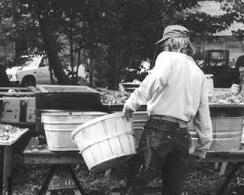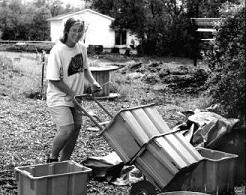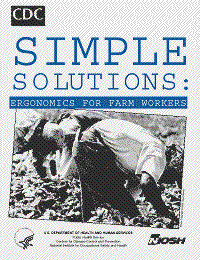|
Standard Containers:
| Problem: |
One Solution: |
| Non-uniform containers are difficult to use. |
Standardized containers for your produce. |
 |
 |
Carrying round crates or baskets is awkward;
center of gravity is too far from the
body. |
When you carry square or rectangular containers,
the center of gravity is close to
your body. |
Non-stacking containers require you to
stoop and bend more often. |
Containers stack, which saves on bending
and stooping. |
Missing and poor handles make crates difficult
to carry. |
Containers have molded, sturdy handles. |
| It is hard to estimate crop yield using nonstandard
containers. |
Crop yield is easy to estimate with standard-
sized containers. |
Containers may be too large or too small
for the product. |
Several sizes are available for different
uses and loads. |
Cardboard and wooden crates are hard to
sanitize. |
Plastic containers are easy to sanitize. |
Standard Containers
Are Standard Containers Worth It?
Standard containers cost about $5-$10 apiece.
Their durability, versatility, and ease of use may
save you money in the long run. More efficient
work using standard containers-compared to
using assorted baskets, boxes, crates, and
pails-may produce indirect savings. These
would include faster harvest and handling, less
stress and strain on your body, and easier monitoring
of crop yield. You can save field time by
tossing empty containers to strategic places
along the harvest row.
Standard containers can be used to wash and
drain produce as well as for transport. Some
have rounded bottoms so they can be used as
"sleds" in the field or used as wash basins in the
packing shed.
Standard containers made of plastic polymers will
last for many years. Standard containers nest to
save storage space. You can help prevent the
spread of plant diseases by regularly washing
plastic containers. Be sure to sanitize all surfaces
of the containers, both inside and out. Containers
should not be stacked on soil to dry, nor should
you stack cleaned containers if they have been in
contact with soil. Containers that fit the size and
weight of your produce may improve harvested
crop quality, since less loss will occur from damage.
Are There Tools that Complement
Standard Containers?
Standard containers can be stacked on narrow
pallets or full-sized pallets and then entire pallet
loads can be moved with a hand truck or
hydraulic pallet jack.
Where Can I Get
Standard Containers?
A number of companies sell standard containers.
Check ads in magazines such as the American
Vegetable Grower, Growing for Market, and The
Packer for sources. The following list of companies
is provided as a convenience for our readers.
It is not an endorsement by the University of
Wisconsin-Extension, nor is it exhaustive.
Buckhorn Inc.
55 W. TechneCenter Dr.
Milford, OH 45150
800-543-4454
CSA Works
121 Bay Rd.
Hadley, MA 01035
413-586-5133
recycled containers; bulk orders for
small- and medium-sized growers
Perstorp Xytec, Inc.
9350 47th Avenue SW
Tacoma, WA 98499
800-423-3221
Contact Information
This material was developed by the Healthy
Farmers, Healthy Profits Project, whose goal is to
find and share work efficiency tips that maintain
farmers' health and safety and also increase profits.
For more information, visit our web site at
http://bse.wisc.edu/hfhp/ or call 608-265-9451.
Healthy Farmers, Healthy Profits Project,
Department of Biological Systems Engineering,
College of Agricultural and Life Sciences,
University of Wisconsin, 460 Henry Hall,
Madison, WI 53706.
Feel free to reproduce; please
mention source.
|


